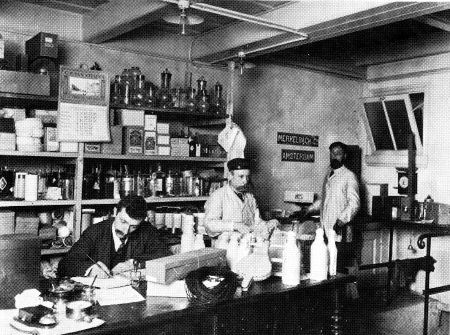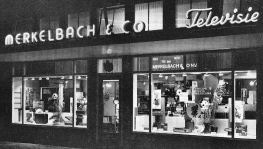

The company Merkelbach & Co traces its origins to the long-established Merkelbach family business in Amsterdam. As early as the 18th century, Johann Wilhelm Merkelbach (1758–1833) settled in the city and was active in the trade of soap and apothecary goods. His descendants continued the trade: in 1845, his son and grandson founded Merkelbach en Zoon (“Merkelbach and Son”) on Achterburgwal in Amsterdam. The official founding date of Merkelbach & Co is 12 December 1870, when J.W. Merkelbach & Co was registered at Kloveniersburgwal (near Rusland Street). The firm initially specialized in the production of hard and soft soap. The founder was a fourth-generation descendant of the family, Johann Wilhelm Merkelbach (1817–1880), whose name appeared in the official registration of the new company.
Over time, the company underwent a dramatic transformation. The founder’s son, Johannes Wilhelmus Merkelbach (1847–1898), became fascinated by modern inventions and technology rather than the traditional soap trade. In the last quarter of the 19th century, under his leadership, Merkelbach & Co began to sell optical and scientific instruments, technical novelties, and innovative toys. The assortment quickly expanded to include magic lanterns (toverlantaarns), sciopticons, dissolving view projectors, microscopes, telescopes, stereoscopes, cameras, and miniature steam engines and toy trains.
One of the early successes of the company was that one of its first magic lanterns was purchased for the young Princess Wilhelmina, the future Queen of the Netherlands. The popularity of projection devices grew rapidly, and the company not only sold them but also began to produce projection slides and components in-house. By the late 1880s, Merkelbach & Co was providing public slide shows and had begun producing educational slides and photographic sets. The firm also issued stereoscopic photographs and teaching slide sets depicting landscapes and scientific subjects, working with educators and naturalists such as M. Broekhuijsen and J. Thijsse. Around 1912, the company published stereoscopic educational photo sets for schools — a forward-thinking contribution that cemented its reputation as a pioneer in visual education.
In the 1870s and 1880s, the store was located on Nieuwendijk. Seeking larger premises for demonstrations, the firm moved to the bend of Nieuwendijk, numbers 57–59, in the “De Ramskooi” area. Business flourished, and alongside optical goods the company even sold fireworks — an idea that ended disastrously when, in 1883, a fire broke out in the shop, destroying it completely. Nonetheless, Merkelbach & Co quickly recovered and opened new branches on other busy streets of Amsterdam — Damrak, Utrechtsestraat, and Leidsestraat. By the late 1880s, the company was firmly established as the leading Dutch supplier of projectors, photographic equipment, scientific instruments, and technical toys.
By the beginning of the 20th century, the enterprise had fully devoted itself to technical and educational merchandise. In 1911, the main store relocated to Kalverstraat 30, one of Amsterdam’s busiest commercial streets. Initially, the shop combined technical novelties with luxury goods, but the focus soon shifted exclusively to scientific instruments, optical devices, and precision toys such as steam engines, cameras, and electric trains. The shop on Kalverstraat became a local landmark — a “technical toy store” where both children and adults could admire the latest technological wonders.
Beyond retail, Merkelbach & Co actively promoted visual learning. In cooperation with teachers, the company published stereoscopic educational sets for geography, nature studies, and history. In 1905, in collaboration with educator M. Broekhuijsen, the company released an extensive collection of stereoscopic school images — more than 30,000 photographs for classroom projection. Around 1912, together with naturalist Jac. P. Thijsse, it produced color slides of birds for teaching natural history. Such initiatives demonstrate Merkelbach’s central role in advancing visual pedagogy in the Netherlands.
The company also developed innovative marketing strategies to make expensive educational toys accessible to more families. In the early 20th century, children from modest backgrounds were encouraged to collect waste paper, which could be exchanged for credit toward toy trains. Merkelbach & Co partnered with the recycling firm Wessels, which bought old newspapers and converted the proceeds into store credit. This early recycling-for-reward system not only allowed more children to afford high-quality technical toys but also strengthened the company’s community presence.
By the 1930s, Merkelbach & Co had become an established family business. In June 1934, it was officially incorporated as a public limited company (N.V.), with Johan Merkelbach as director. At that time, the company was widely known as a premier supplier of scientific, photographic, and educational apparatus. The Second World War posed serious challenges, yet the firm managed to survive. After the war, under new management — notably W.L. Waltman, who directed the company until his death in 1967 — the business thrived again. Waltman was succeeded by M.A. Waltman-Merkelbach, likely his widow and a member of the founding family.
On 1 February 1953, Merkelbach & Co received the prestigious title of Hofleverancier (Royal Warrant Holder), acknowledging more than 80 years of continuous excellence and integrity in trade. During the 1950s, the company expanded into modern technology. That same year, a new division called Merkelbach Fysica opened at Kloveniersburgwal 31, focusing on educational and physical science instruments. It was managed by Johann Wilhelm Merkelbach VII, a seventh-generation descendant. Meanwhile, the firm entered the consumer electronics market: in 1956, it opened a new store on Beethovenstraat 178, specializing in radios and televisions, followed in 1957 by a seaside branch in Zandvoort. By the mid-20th century, Merkelbach & Co had evolved into a multifaceted company offering both traditional optical and scientific instruments and modern household electronics.
By the 1970s, however, the company began to decline. The Merkelbach Fysica division, dealing in educational instruments, was closed in 1978, and the Beethovenstraat branch had already shut down in 1976. The main Kalverstraat store — once the legendary “technical toy shop” of Amsterdam — also ceased operations around this time. Archival records of the firm end around 1980, marking the end of its 110-year history.
Although Merkelbach & Co left no direct successor, its legacy endures in Dutch industrial and educational history. Over more than a century, the company evolved from a family soap workshop into a renowned supplier of optical, scientific, and educational instruments. It served schools, universities, and enthusiasts, played a pioneering role in the introduction of visual learning aids, and was recognized as a Royal Warrant Holder. Its name remains synonymous with quality, ingenuity, and the spirit of Dutch craftsmanship.
Sources: